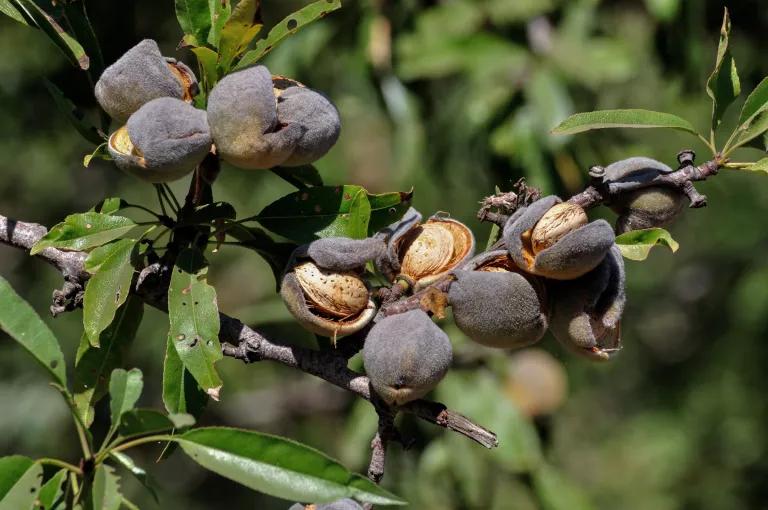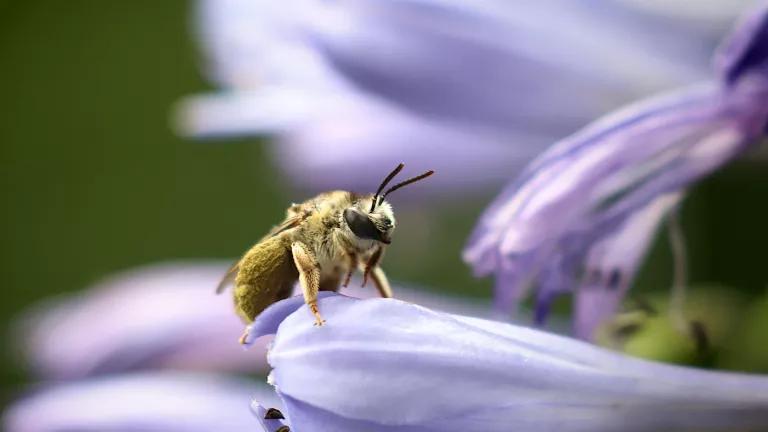5 Things to Know About CA Bill to Curb Bee-Killing Neonics
Widespread neonic use is a leading cause of pollinator declines and linked with bird losses, ecosystem collapse, and risks to human health.

Bee collecting pollen in Long Beach, California
California just became the latest state to move toward curbing neurotoxic neonicotinoid insecticides, or “neonics.” AB 2146, introduced by Assemblymember Rebecca Bauer-Kahan and co-sponsored by NRDC, Environment California, and California Native Plant Society, would ban nearly all non-agricultural uses of these bee-killing pesticides--like those on lawns, gardens, and golf courses. The bill follows the lead of groundbreaking legislation in Maine and New Jersey. Its passage in the most populous state in the nation would mark a turning point in the years-long battle to rein in neonics, which contaminate lands and waters nationwide and threaten bees, birds, and entire ecosystems—and even people.
Here are five things to know about neonics in California and this pivotal bill:
California has a neonic problem
Neonics are a class of neurotoxic insecticide first introduced in the 1990s. Today, they are the most widely used insecticides in the country. They are incredibly toxic to bees and other insects and are designed to permeate plant tissues—making the whole plant poisonous to insects. Neonics also move easily in water and can last for years in soil, meaning they uniquely good at contaminating the environment.
While neonics contaminate soil, water, and plant life across vast areas of the country, few states experience neonic contamination quite like California. The California Department of Pesticide Regulation (DPR) has detected neonics in 92% of urban water samples in southern California, 58% in urban areas of northern California, and a whopping 94% in agricultural areas of the state. This strongly indicates that neonics are nearly ubiquitous in the Golden State’s soil and plants, too.

People at a park in Laguna Beach, South Orange County, California. Urban waters in areas of southern California, like Orange County, are heavily contaminated with neonics.
Neonics decimate bees, threatening California’s agricultural economy
A mountain of evidence shows that neonics are a leading cause of mass bee die-offs over the past two decades, threating pollinator-dependent agriculture across the nation. Neonics can kill bees at extraordinarily low levels; just one square foot of grass treated with a neonic at EPA-approved levels can contain enough neonic to kill over a million bees. But they can have sublethal effects at even lower levels. This means even if they don’t kill bees outright, neonics can impair bees’ reproduction, memory, and immune and cognitive functions in ways that make it harder for them to survive and reproduce.
For one of the biggest agricultural producers in the country, that’s bad news. Declining bee populations threaten over $15 billion annually in agricultural production in California. Many of the state’s most valuable crops, including almonds, grapes, and a variety of berries, are dependent—in whole or in part—on pollination by bees and other insects.

Almonds bursting from the hull on a tree and ready for harvest in Chico, California.
Neonics harm more than just bees
Neonics also put California’s rich biodiversity and nearly 40 million residents at risk. A third of North America’s birds have disappeared in the past fifty years, and mounting evidence identifies widespread neonic use as a major contributor to the declines. Neonics can kill or impair exposed birds directly, and they also kill insects and other invertebrates that many birds rely on for food. The same goes for fish; research has found that the introduction of neonics can cause the collapse of fisheries by devastating plankton populations that fish eat.
Research has also linked neonic exposure in the womb with birth defects (deformed jaw bones, reduced organ weights) in white-tailed deer as well as higher rates of death for fawns. Importantly, these findings—as well as other human and animal research—raise concerns about neonics’ impacts on another large mammal: humans. Over half the American population is exposed to neonics on any given day, and neonic exposure is linked with a variety of health risks—including increased risk of malformations of the developing heart and brain.
Non-agricultural uses are a critical part of the neonic problem
Widespread neonic contamination in urban areas shows that non-agricultural uses—like on lawns, gardens, golf courses, and other landscaping—contribute significantly to harmful contamination of the environment. These uses also present exposure risks for people, because they are used on lawns and other areas where pets and children play. And people are already commonly exposed through contaminated food and drinking water.
Ironically, non-agricultural neonic uses are frequently not necessary at all. For example, neonics are often applied to lawns preventatively, before there is any evidence of a pest problem. Where pests are a problem, other, less harmful alternative treatments are available.
Simply put, non-agricultural uses of neonics are the least justifiable out there, needlessly introducing massive amounts of a neurotoxic pesticide into the environment.

Manicured lawns come at a serious cost. Neonic lawn uses significantly contribute to environmental contamination and can pose risks to children and pets.
AB 2146 brings California up to speed
Despite neonics’ many risks, California has been slow to act. DPR has been working for several years to regulate some agricultural uses of neonics, but critical gaps in the agency’s plans remain. As my colleague has blogged about, DPR has no plans for tracking or regulating neonic-coated crop seeds. Troublingly, DPR also has no plans to rein problematic non-agricultural neonic uses.
AB 2146 steps in to fill this critical gap and would ban these needless non-agricultural neonic uses. By passing this bill, California would become a leader in protecting its pollinators, farmers, wildlife, and people (and especially children) from neurotoxic neonic pesticides. That is why NRDC is co-sponsoring and strongly supporting this legislation. Check back for updates and to see what you can do to support this critical bill.




